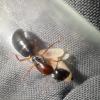Indeed, and Pogonomyrmex have issues climbing and moving across smooth surfaces. A substrate-less test tube for them would be like your whole house's flooring being wet, slippery bathroom tiling and you wear socks all the time: a head injury waiting to happen.
That is true and reading that research post, it states that nests made out of dirt had a WAY better founding chance and one of the first thing that kills this species is that fact that they have low traction on flat surfaces.
I wouldn’t use that Utah ant post as the Bible. It can only be described as an observation and not lead to causation since it’s not a randomized controlled study. We also don’t know how many queens were involved in his observational study. there are just way too many factors involved. You can only conclude that using dirt box is a viable way to found pogonomyrmex. I have founded many Pogonomyrmex in just plain test tubes and they do fine. I think more important is heat and humidity level and secondary is having substrate or not.
While I agree with this, there are two different time samples in this pseudoscientific experiment, and he is a bulk distributor here on Formiculture. I am not using his post as an Ant Bible, however there is no research countering it. If you could observe and give percentages as to how many of your queens did fine, then I would be less likely to reference Utah Ants post about the success of dirt setups. Did you measure the heat level you kept your ants at?
As mentioned earlier, there are just too many factors involved. Dirt box set up is probably different than a test tube with dirt in it. That needs to be tested. What is the benefit of dirt set up? Is it the substrate that allows the queens to grip or that it mimics natural environment? Test tube by far is the best for providing constant temp and humidity levels. You will need to ask other bulk distributors what their successes are. Majority if not all distributors found Pogonomyrmex in test tubes. there are many down sides to dirt box set ups compared to test tubes: unless you are from an area with native Pogonomyrmex, the dirt you are going to use is probably not ideal. The wetness of the dirt and how often do you need to water the dirt. The tunnels and chambers are prone to collapse killing the queen. You will have to move them out of the dirt box once they found. Shipping ants in dirt box or even in test tube with substrate is highly dangerous etc….
Here is where I am confused. You claim that test tubes are just as good at holding Pogonomyrmex, yet are shifting the burden of proof of proving otherwise onto others. Although I agree with you respectfully that there are a lot of variables and that the information in Utah Ants post is not a research report, I think it holds merit, and here is why.
To eliminate variables, we are comparing a fully dirt setup as he used to a test tube with no substrate.
You firstly mention that test tubes are the best for control (temperature and humidity) which I completely agree with. It is easy to control as well as see the development inside.
Then you mention that someone needs to ask more bulk distributors about their success rates, and if they are low, as they use test tube setups. I have a couple of responses here. A phenomenal example of die-off rates from a bulk distributor using test tubes can be found here. These statistics closely mirror the high initial die-offs experienced by Utah Ants with test tubes, although they cover a different species, so I agree with you that more research needs to be done. Secondly, all I wanted to know is what you think your success rate was for the test tube setup, knowing that you have kept ants for a long period. Did you also have these initial die-offs, and approximately what percent? Was your success rate close to the 80% mark?
Nonnative dirt is a valid concern, I agree with you there. However you list a long list of variables after this that need to be accounted for (some of which Utah Ants talks about by the way). Pointing out variables that need to be taken into account does not make up for the fact that Utah Ants has 2 years of data and you have not mentioned any.
I in no way wish to argue with you on this thread, however, I believe that data, even if it is not perfect, is important, which is why I mentioned it above.
Edit: in rereading my initial post, I could have worded it better to imply that dirt could improve the setup of pogonomyrmex, and is not necessary for it; perhaps this changes your response?
Edited by Ants_Dakota, October 9 2024 - 10:07 AM.
























